3.6 Artificial Intelligence
1/52
There's no tags or description
Looks like no tags are added yet.
Name | Mastery | Learn | Test | Matching | Spaced |
|---|
No study sessions yet.
53 Terms
What are the inherent problems with AI?
Most people cannot describe how they do things
Difference between how human brain is structured and human capabilities compared to that of a computer
The best way for a machine is often different to that of a human.
What is the Turing test and how does it work?
a method of inquiry in AI for determining whether or not a computer is capable of thinking like a human being. Can only test natural language processing
interrogator on one side of a screen → asks questions to players on the other side for 5 minutes
One of the players → computer (chatbot)
The interrogator mistakes the computer for a human <30% of the time → computer has passed the artificial intelligence test
How and when was the Turing test used in early chatbots?
The Turing Test was used on early chatbots (example: ELIZA in the 1960s)
It took over 60 years before a chatbot passed the test
In 2012 a chatbot posing as a 13 year old Ukrainian boy convinced the integrorator it was human.
What is CAPTCHA?
CAPTCHA: Completely Automated Public Turing Test to tell Computers and Humans Apart
Modern-day Turing test
users can prove at time of registration they are human not bot (through questions)
preventing scammers from spamming, protect online poling
text based, imaged based and audio—>challenges that ensure legitimate users can access services without automated interference.
Define Weak/Narrow AI?
Artificial intelligence that has a limited function or can only perform a specific task.
The AI we encounter day to day.
Example; Netflix (can only do 1 task: recommended what to watch next)
Example; Google search, siri, self driving vehicles, facial recognition.
Many of these are changing the world by completing tasks much quicker than humans by discovering patterns in big data.
Define Domain-Specific AI?
Artificial intelligence that perform tasks better than humans in certain domains
Examples; AI that can detect cancer beter than human doctors, and AI such as AlphaGo: developed by DeepMind to beat the world champion at the board game Go.
Define Strong AI?
Artificial intelligence that can develop consciousness and make decisions better than humans.
Strong AI will be able to demonstrate self-awareness and emotions, and have full human cognitive abilities, which it currently cannot.
Also known as full AI or AGI
Define Super AI?
Artificial intelligence that surpasses human intelligence.
The next goal after strong AI is achieved. There are concerns around this AI that machines will overthrow the human race.
Define Singularity?
The hypothetical future where artificial intelligence becomes so advanced that it is superior to human intelligence.
Nanotechnology is perceived as one of the key technologies that will make this a reality.
Define Expert System?
A computer system that acts like a human expert in a specific subject area.
Often used to advise non experts when a human expert is not available.
Has 3 main components: The user interface, interference engine and the knowledge base.
Example of domain-specific AI and is frequently used in media or car diagnosis, financial advising, identifying unknown items.
Explain the components of an Expert system?
User interface: Part of the system that allows non-expert to ask questions of the expert and receive advice.
Knowledge base: Facts and rules in an expert system. Created by a knowledge engineer who collects information provided by human experts.
Interference engine: The part of an expert systems that uses programmed rules to interpret and evaluate the facts in the knowledge base.
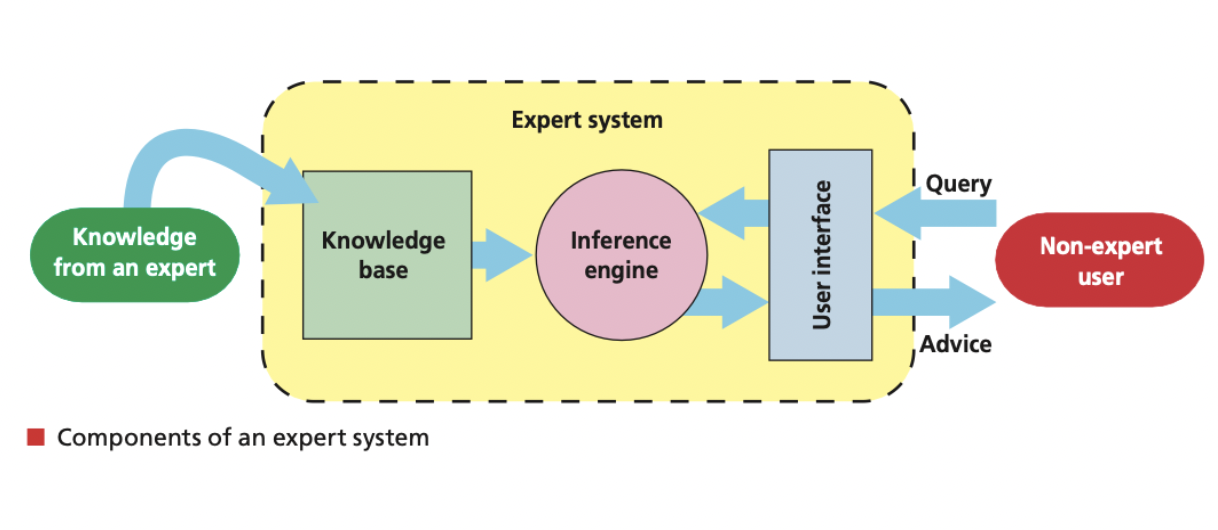
What are the different types of machine learning
Supervised machine learning: simplest form; algorithms learn by example, training data has set of inputs each paired with correct outputs→ algorithm searches for patterns in data that correlate to desired output→after training, algorithm fed new & unseen inputs to determine how to label input. can have dif algorithms for dif purposes: classification algorithm, regression algorithm
Unsupervised machine learning: used to find underlying patterns in data that cannot be noticed by humans, uses data sets without labels- uses data features, algorithms use cluster analysis which looks for ways to group data, applications include social networking
Reinforcement learning: based on rewarding positive behaviour, algorithm trained by rewarding system for + and gives penalities for -, requires lots of data, Ex: autonomous vehicles, games, robotics
Deep learning: used for more complex problems, uses artificial neural networks: NN consisting on 3+ layers=DL, applications include facial,speech & image recognition, Natural language processing
What are the Key elements of machine learning?
Needs a set of good data (called training data)
Uses algrothims (based on a computer model) to look and understand data
Data is input into the algorithm to make a prediction
Prediction is then evaluated and if innacurate, fed back into the system to update model/algorithm
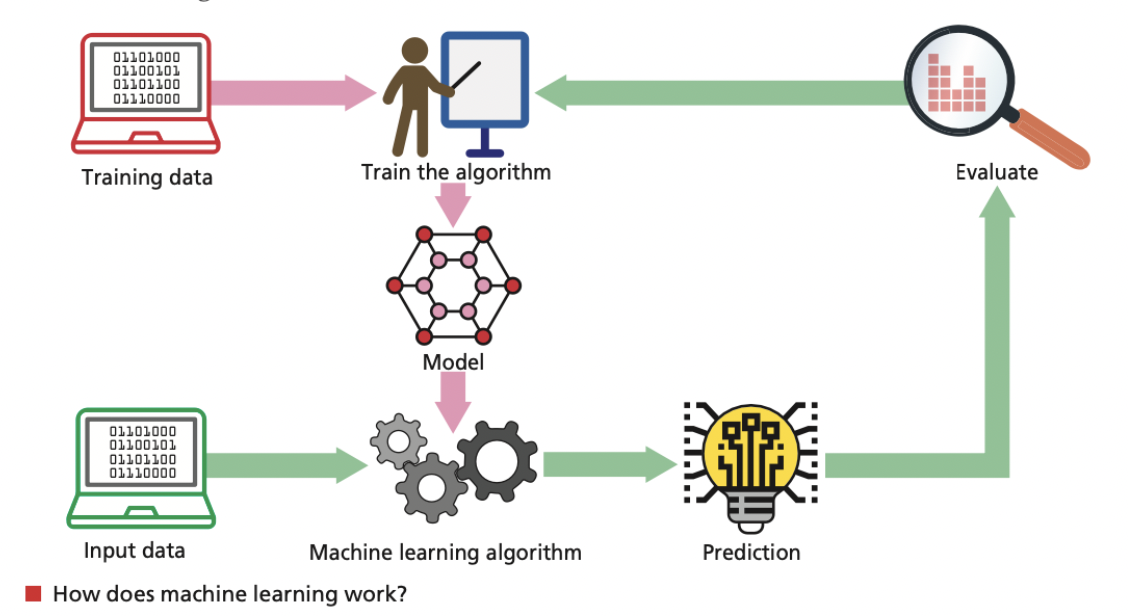
Define and explain Supervised learning
Simplist form of machine learning with algorithms learning by example:
Training data consists of set of inputs each paired with correct outputs
During training process the algorithm searches for patterns in the data which can correlate to the desired output.
Once the system has been trained, it is fed new and unseen inputs to determine which label to give the new input.
It is considered supervised because the system is trained with known outputs and the algorithm is adjusted until it can produce correct outputs for unseen inputs.
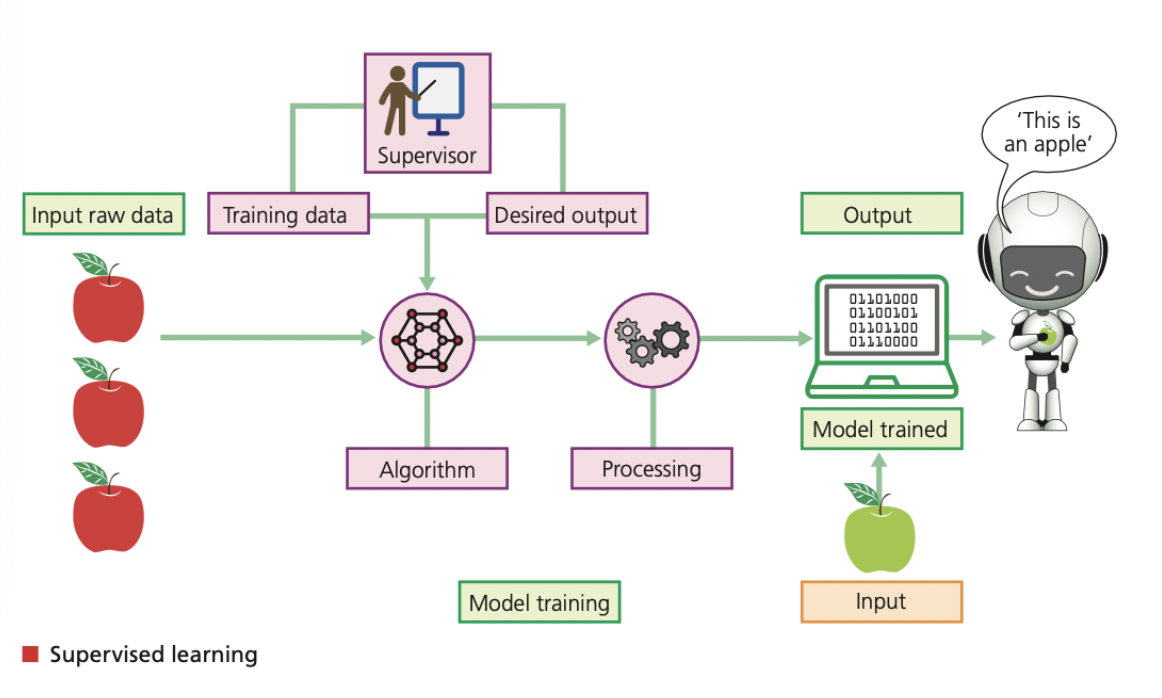
What different algorithms are used Supervised learning and for which different purposes?
Application using supervised learning: spam filters, fraud detection, handwriting recognition
Classification algorithm: will take input data and assign it to a category that is based on the training data.
Regression algorithm: is different in that it is used for predictions and looks at the relationship between variables. Commonly used to make predictions such as test scores based on analysis of the data set.
Define and explain Unsupervised learning?
Unsupervised learning is used to find underlying patterns in data.
Uses data sets that do not have any labels but instead uses datas features.
The goal is to analyze data with hidden patterns that cannot be noticed by humans.
Algorithms use cluster analysis, which looks for ways to group the data.
Applications using unsupervised learning include: social networking and market segmentation
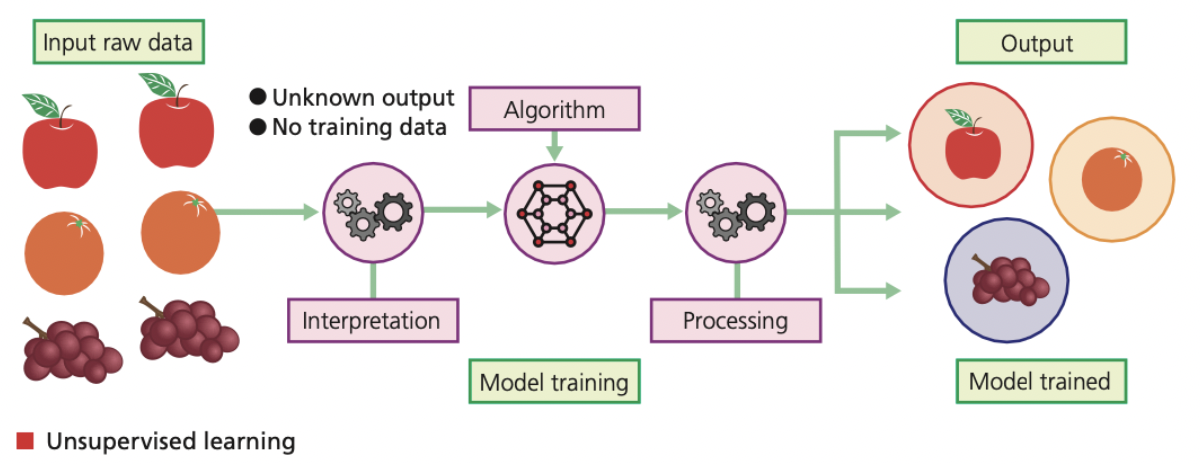
Define and explain Reinforcement learning
Type of machine learning based on rewarding positive behaviour:
The algorithm is trained by rewarding the system if it performs correctly and gives penatlities for incorrectly.
The software makes decisions to maximise rewards and keeps adapting to the environment.
Requires lots of data which is why some of the first applications were based on how readily available the data was.
Applications include: autonomous vehicles, games and robotics
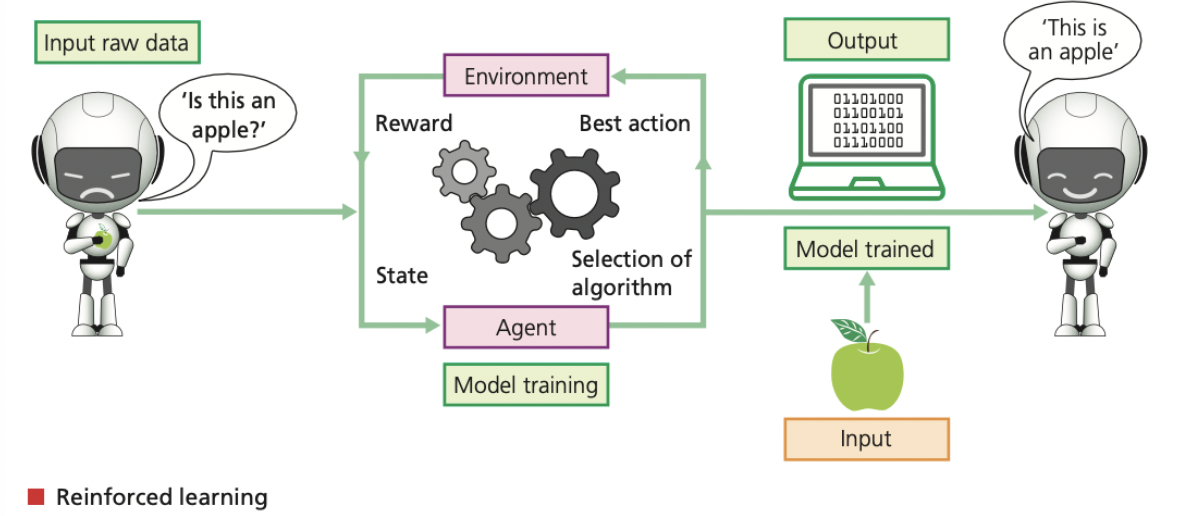
Define and explain Deep learning?
type of machine learning that is used for more complex problems.
Does not require structured data, instead uses artificial neural networks.
A neural network consisting of more than 3 layers is considered to be a deep learning algorithm.
Applications include: facial recognition, image recognition, natural language processing and speech recognition.
What are the uses of Machine learning?
Pattern recognition
Data analytics
Natural language processing
Image recognition
Voice and sound recognition
How does pattern recognition use machine learning?
Pattern recognition uses machine learning algorithms to recognise patterns; these can be either observed physical patterns or mathematical patterns.
Pattern recognition is used for many different purposes.
How is machine learning used in Data analytics?
Data analytics is used in stock market forecasting and audience research:
In stock market forecasting, pattern recognition is used to analyse the changing values in the stock exchange in order to make predictions.
Audience research, such as Google Analytics, uses pattern recognition to analyse user data for market segmentation.
How is machine learning used in Image recognition?
Image recognition is used to understand what is in a picture so that it can describe the picture and the image can become more searchable. Two uses of image recognition include:
Image search: google image search uses pattern recognition and meta data in its search algorithm
Facial recognition: recognizing someone from using their faceprint in applications. Ex. unlocking a phone
How is machine learning used in Voice and sound recognition?
Voice and sound recognition works by analysing patterns of sound that can be converted into text and applied to natural language processing. This can be used in:
AI assistants so users can interact using voice commands
Speech-to-text and text-to-speech translation, allowing users to convert spoken words into text on screen vice versa. Ex. automatic caption creation on youtube.
How is machine learning used in Sentiment analysis?
Sentiment analysis can interpret someone’s mood or intent using pattern recognition.
This is commonly used in audience research or customer relationship platforms to gain more information about a customer’s response to a product or service.
Define Neural networks
Systems with interconnected nodes that work in a similar way to neurons in the human brain
Define and explain neural networks
Neural networks→Systems with interconnected nodes that work in a similar way to neurons in the human brain:
Nodes are activated when there is sufficient input, which continues to provide input for the next series of nodes and so on, until it produces an output.
The connections between the artificial neurons act in a similar manner to real synapses, enabling signals to be transmitted from node to node.
The signals move from one hidden layer to another, being processed on the way as they travel from the first input to the last output layer.
When given input stimulus the neurons run mathematical calculation to figure out if there is enough info to pass the info on to the next neuron.
Example: data inputs received are added up and if the sum is more than a certain threshold value the neuron “fires” and activates the neurons connected to it.
Decribe the steps of neural networks
Data is fed into a neural network through the input layer, which communicates with hidden layers.
Processing takes place in the hidden layers through a system of weighted connections.
Nodes in the hidden layer combine data from the input layer with a set of coefficients and assign appropriate weights to inputs.
These input-weight products are then summed up.
The sum is passed through a node’s activation function, which determines the extent that a signal must progress further through the network to affect the final output.
Finally, the hidden layers link to the output layer, where the outputs are retrieved.
What are the advantages of neural networks?
Can learn and model non linear and complex relationships *important as many scenarios in real life are non linear
Can generalize and infer relationships from unseen data
Do not impose a restriction on the input variable.
Give a real world example of where AI neural networks are used?
Currently used in image processing and forecasting
RWE:
GitHub
The GitHub coding program uses a model called Codex which uses a large artificial neural network to predict text and computer code
It uses billions of lines of code stored on GitHub to learn how to write code, not all of which is bug free
Explain how AI has evolved in Science fiction and Philosophy?
AI features strongly on the imagination of many famous science fiction writers
The most violent depiction of an AI-dominated word = “I have no mouth and I must scream” by Harlan Ellison in 1967 where AI killed the whole human race
Ellison was one of the first writers to understand that a machine with consciousness and emotions would be problematic
Define and explain Cybernetics?
Cybernetics→The study of communication and control in both living things and machines, especially automatic control systems such as the human nervous system, and mechanical–electrical communication systems.
1950 Alan Turing was credited for coming up with the idea that machines could think.
Technology remained promising, however popularity of AI developments has its peaks and dips.
Research officially began in 1956 asking to unify research in cybernetics
Define and explain AI winters in the evolution of AI?
AI Winter→is a period in which funding and interest in research and development of artificial intelligence is reduced.
The first AI winter occurred between 1974 and 1980: - Researchers at the time had made promises about artificial intelligence developments that did not materialize. Many agencies cut their fundings.
Next peak in AI was the development of expert systems (considered a move in the right direction)
First expert system: named Dendral was develop dto analyse chemical compounds 1965 at Standford university.
Expert systems became very popular in the 1980s→ attracted funding from tech companies + government.
The market then collapses and second AI winter occurred.
Define and explain the Singularity and multiplicity in the evolution of AI?
As AI evolved, so did the concern for the future civilization. 2 key thinkers of the time predicted a future where tech growth would be out of control and irreversible where the boundary between humanity and computers wouldnt exist (singulairty) - was popularised by Vinge in 1993
In 2005 Kruzweil published his book on singularity preducitng that it would be achieved by the year 2045 using super human AI.
Late 2000s early 2010s = another boom with advances in machine and deep learning. Two factors explaining this boom: 1. Availability and access to massive amounts of data 2. Developments in computer graphic cards and microprocessor → making the increased processing capabilities needed for AI possible. These developments became the focus of large tech companies and triggered AI summer.
Multiplicity→A future in which artificial intelligence and robots are developed to work alongside people, rather than to replace them.
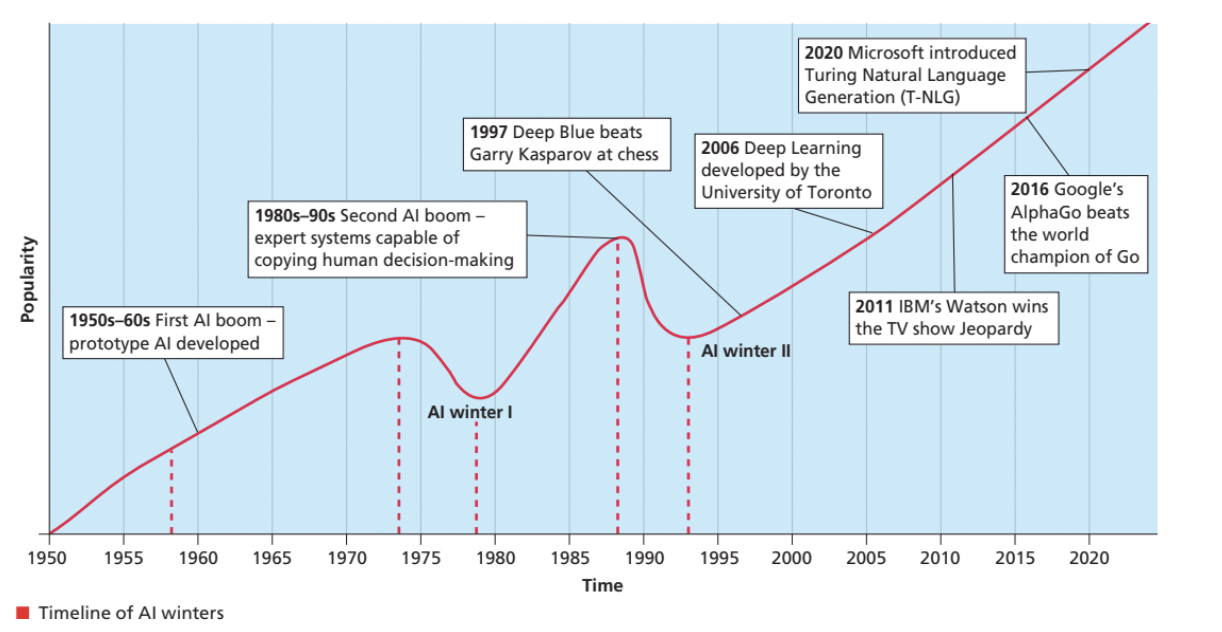
Define Cybernetics?
The study of communication and control in both living things and machines, especially automatic control systems such as the human nervous system, and mechanical–electrical communication systems.
Define AI winter?
a period in which funding and interest in research and development of artificial intelligence is reduced.
Define AI summer?
AI summer leading to increase in AI developments, public have become concerned about what AI may mean for future jobs. + predictions on singularity came the concern that many jobs will be replaced by AI.
-Has already been seen in the manufacturing industry (robot driven factories)
Define Multiplicity?
Multiplicity→A future in which artificial intelligence and robots are developed to work alongside people, rather than to replace them.
List the AI Dilemmas?
Fairness and bias in design and use
Accountability in design and use
Transparency in design and use
Uneven and underdeveloped laws, regulations and governance
Automation and displacement of humans in multiple contexts and roles
List the key parts of the evolution of AI
AI in science fiction and philosophy
Cybernetics
AI winters
The singularity and the multiplicity
List the uses of AI neural networks
Learn and model complex and non-linear relationships
generalize from initial inputs
List the Types of Machine learning?
Types:
Supervised
unsupervised
reinforcement learning
deep learning
List the uses of Machine learning?
Uses:
Pattern recognition
facial and speech recognition
image analysis
natural language processing
List the types of AI
Strong/full AI
weak/narrow AI
Domain-specific AI
Super AI
Singularity
Why is the development of AI important?
Allows for the automation of the discovery of data and can automate certain computerized tasks more reliably and without getting tired e.g. when detecting fraudulent transactions, AI can operate 24-7 & send alerts for human intervention.
AI can also add intelligence to existing products e.g. our home appliances or security intelligence in the workplace.
Since AI is adapting through learning & can analyse data more deeply: can be more reliable in classifying and making predictions:
Developments in deep learning have made AI systems more accurate & are consequently being widely used in the medical field e.g. analysing MRIs for cancer.
Data now more important than ever: with right data & sophisticated AI=more & more answers are being provided
Explain how fairness and bias is a global dilemmas created by AI and what the role of AI designers is in minimizing it?
Fairness and bias:
A limitation of AI is that it learns from the data fed into the system= any inaccuracies in data will be reflected in the results
This has been especially seen in systems designed on biased data sets or algorithms
Role of AI designers & developers is to minimize algorithmic bias through research & data collection that represents whole populations
Explain how Accountability in design and use is a global dilemma created by AI and which questions should one ask when discussing accountability?
Accountability in design and use
In development of AI, developers are responsible for designs, developments, outcomes, & impact system has on world: this becomes increasingly hard when you consider range of uses & dif types of AI that are being developed.
When discussing accountability, one should ask these questions:
How does accountability change if end-user has more influence over an AI system?
How does accountability change if the AI is being used to support decision-making or make decisions on its own?
Explain how a lack of transparency in design and use is a global dilemma created by AI?
→As deep learning algorithms evolve over time: possible that developers won’t be able to explain the ‘black box’ nature of the AI system
Unlike tradtional programs, developers cannot just examine the code to test it for bugs to make them more reliable or see decision-making process clearly
As users of AI technology, if its not performing as expected we would want to know why
4 main problems:
Unexplainable algorithms: when AI is drawing conclusion (either during classification or regression) there is no visible understanding of how it was reached
Lack of visibility in training data sets: It’s not always clear where training data has come from, whether its been cleaned or if its even accessible.
Lack of visibility in methods of data selection: even if developers were given access to training data, this could be petabytes of data: they might not know however, which aspects of data was actually used→ one would want to know this for transparency
Poor management of model versioning: As models are continuously developed→ sometimes hard to keep track of which version is being used.
As society strives for greater transparency, it can come with its weaknesses as well: if people can understand how an AI is reaching its decisions, poses two threats:
Easier for hackers to try and work around the system
Easier for competitors to steal the AI algorithms
Explain how transparency is a solution to how AI should be designed so humans can understand its decision making process easily?
AI should be designed so humans can understand its decision making process easily→SOLUTION to this is transparency:
As AI’s capabilities increase→ impact of AI on society also increases
Should be possible to explain AI’s decision-making to people clearly, & for people to see how its conclusions & recommendations have been formed: ESSENTIAL if developers want end-users to trust the systems
People should be aware that they are interacting with an AI system at all times, EVEN IF the designers want a flawless experience

How is AIs carbon footprint a global dilemma created by AI?
University of Massaschusetts Amherst research paper estimated carbon emissions when training a neural network are same as a car
Factors influencing carbon footprint include:
The algorithm & its training time
The processing unit
The energy efficiency of the data centre
The type of energy used in the data centres
CodeCarbon→open-source project being developed to estimate carbon footprint of computing with aim of helping data scientists make more environmentally friendly decisions.
How are uneven and underdeveloped laws, regulations and governance a global dilemma created by AI?
Rapid pace of AI adoption has created strain on existing regulations→ laws struggling to keep up
Early 2020s: Cognilytica released report based on investigation into actions taken by countries around world:
concluded many countries weren’t rushing into developing laws & regulations on AI
Instead countries waiting to see how tech was being used before establishing laws
Another area researched was level of discussion regarding restrictions of lethal autonomous weapons systems (LAWS):
At time of report, Belgium was only country that passed this legislation while 13 countries discussed
This leaves tech companies in dilemma: without the laws, their technology might not be legal to operate
e.g. autonomous vehicles to be allowed on roads→ laws must be written to permit them: LAWS report showed only 24 countries had laws allowing operation of autonomous vehicles
User data rights→ another aspect of AI gaining regulatory attention:
Since developments in AI require large data sets to train with: data sets may include data from people, collected by IT systems they have signed up for→ this makes it even more important that organisations comply with data protection laws
Explain the concerns created by AI about how widespread use of AI will impact employment in regards to Job losses and negative impacts on employment?
Rapid dev. of AI creates concern about how widespread use of AI will impact employment: will AI replace jobs, support existing jobs or create new jobs?
AI is only capable of narrow tasks or intelligence: limitation of AI→ humans have more generalised intelligence that will continue to be important
World Economic Forum report concluded that advances in AI could potentially replace large proportion of jobs:
AI used to automate tasks predicted to replace 75 million jobs by 2025
In 2020, 2.7 million industrial robots were found in manufacturing, completing heavy-duty work or completing tasks with high precision
Food preparation, construction & driving jobs are area where jobs have been lost to automation
People with lower-level qualifications are most vulnerable group of people likely to lose jobs to AI
More educated employees will need to adapt to technological changes or will be in senior management roles that still require human judgement
Explain which jobs AI will least affect and where AI will create employment opportunities?
World Economic Forum report predicted AI will also create 133 million new jobs
Jobs in sectors such as health, education, scientific and tehnical services will be least affected
Employment opportunities will be based on what AI and robots are no capable of: Jobs requiring care and understanding e.g. caring for elderly, will still be in demand, especially in countries with aging populations
Define Automation?
The increased use of technology in a process, which reduces the need for human involvement